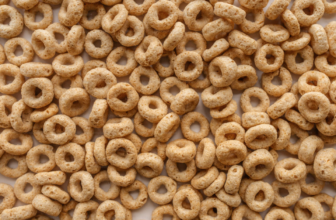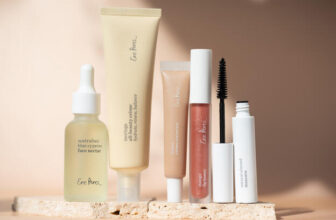
[adinserter block=”2″]
Red Bull contains a mix of sugar, synthetic caffeine and amino acids. These include taurine and several B vitamins, all of which are well-known for their energy-promoting qualities. Take a closer look at some of the powerful drink’s active ingredients, which are listed on the back of the Red Bull can:
- Carbonated Water
- Sucrose
- Glucose
- Citric Acid
- Taurine
- Sodium Bicarbonate
- Magnesium Carbonate
- Caffeine
- Niacinamide
- Calcium Pantothenate
- Pyridoxine HCI
- Vitamin B12
- Natural, Artificial Flavors and Colors
Here’s What’s Really in Red Bull’s Energy Drink
Organic Authority Studio
Glucose & Sucrose:
Do you recognize your old friend sugar? Red Bull has 37 grams of added sugar per can, which is actually a little less than most soft drinks (Dr. Pepper has 40 grams) – but still a massive amount of the sweet stuff. Prepare for an energy rush – and then the inevitable crash.
Sugar free Red Bull contains the artificial sweeteners aspartame, acesulfame K, and sucralose instead of sugar, which have recently been found genotoxic and linked to an increased risk of cardiovascular disease.1 So all of these “healthy alternatives” to sugar may just be a ton of bull! (Fitting though, right?)
Taurine
Alright gym rats/lifters/gym bros, this one’s for you!Taurine, or 2-aminoethanesulfonic acid, is an amino acid naturally made in the human body. Found in the lower intestine and a major component of bile, taurine is an antioxidant that helps to move minerals through the system and generate nerve impulses.
Each can of Red Bull, among other ingredients, contains 1000 mg taurine, and although Red Bull products containing the substance was banned in France for a while, at this point all bans are off and taurine is generally considered safe.

Organic Authority Studio
Caffeine:
In their 8.4 fl/oz can, Red Bull contains 80 mg of caffeine, about half of other soft drinks and about the same as a cup of coffee. Caffeine’s stimulating mental and physical benefits have been well documented, with some even arguing that coffee’s introduction to the Western World made the Industrial Revolution possible.
Caffeine works by blocking adenosine, a sleep-promoting brain chemical, which in turn makes your body release adrenaline. Caffeine is the world’s most widely used psychoactive substance, and over-consumption can cause diarrhea, twitching, racing heartbeat, and nervousness – otherwise known as the “caffeine jitters.” Some say the caffeine content is dangerous, but its really just a bit more than a small cup of coffee.
Glucuronolactone:
This naturally occurring chemical is found in connective tissues and plant gums. A carbohydrate, glucuronolactone is a stimulant with mild anti-depressant effects that helps improve memory and concentration. It also has detoxifying qualities and can help remove waste from the body. But excessive consumption of Glucuronolactone can cause increased heart rate, increased blood pressure, headaches, nausea, and dizziness.
Related: Red Bull may not be the only source of toxic chemicals in your kitchen. Are you cooking with clean cookware? Read the nerdy deep dives on clean non-toxic ceramic cookware and clean bakeware to find out if it’s time to make some changes.
Inositol:
Inositol is a chemical compound and mood-booster that helps the brain use serotonin, and can be found in many foods such as oranges, cantaloupes and high-fiber nuts and beans.
Niacin:
B vitamin that helps with energy formation and use.
D-Pantothenol:
Also known as vitamin B-5 or Pantothenic Acid, D-Pantothenol is an essential nutrient that improves mood, boosts metabolism and helps to turn fat into energy. Vitamin B-5 deficiency has been connected to a host of mental and physical health problems including acne, fatigue, muscle cramps and apathy.

Soekarno Omar
Pyridoxine HCL:
Otherwise known as vitamin B6, pyridoxine HCL helps the body to form red blood cells and use oxygen, improving mood and energy levels.
Vitamin B-12:
Like vitamin B-6, vitamin B-12 helps form red blood cells for oxygen utilization.
Artificial Colors & Flavors:
You didn’t think that glowing pink color was natural, did you? While Red Bull also uses natural flavors, every version of the drink includes artificial flavors and colors.
What About Bull Sperm and Urine? I Don’t See Them on This List
Despite the rumors and enticing urban legends, Red Bull ingredients do not include bull semen, bull urine, or any artificially manufactured stimulants from China. Taurine was first isolated from ox bile, and is indeed found in the large intestines of many animals. But rest assured that the taurine used by Red Bull is synthetically produced in laboratories.
While the word “taurine” takes its name from the Greek word for “bull,” the drink does not take its ingredients from the testicles of a bull.

Shilo Urban
Red Bull Energy Drinks New Editions
Red Bull has ever rotating seasonal flavors of its energy drink, each with a different color – and a few different ingredients: Sea Blue Edition (juneberry), Winter Edition (pear cinnamon), Amber Edition (strawberry apricot), Red Edition (watermelon), Yellow Edition (tropical), Blue Edition (blueberry), Green Edition (dragon fruit), Coconut Edition (coconut berry), and finally, Peach Edition (peach-nectarine).
With their fun, vibrant colors and trendy names adding an air of exclusivity, one might wonder if they’re marketing to a younger consumer (hint: they are). But it’s not only the youth of the world that we need to be concerned about, energy drinks are also targeting boomers (you might want to check your grandma’s fridge).
And for good reason, energy drink companies like Red Bull are capitalizing on the fact that all soda categories are in decline, but guess what’s on the rise? You guessed it, energy drinks.
Sea Blue Edition:
Carbonated Water, Sugar, Glucose, Citric Acid, Taurine, Natural and Artificial Flavors, Sodium Citrate, Caffeine, Color, Niacinamide, Pyridoxine HCI, Calcium Pantothenate, Blue 1 Vitamin B12.
Winter Edition:
Carbonated Water, Sugar, Glucose, Citric Acid, Taurine, Sodium Citrate, Natural and Artificial Flavors, Caffeine, Color, Niacinamide, Pyridoxine HCI (Vitamin B6), Calcium Pantothenate, Vitamin B12.
Amber Edition:
Carbonated Water, Sugar, Glucose, Citric Acid, Taurine, Sodium Citrate, Natural and Artificial Flavors, Caffeine, Color, Niacinamide, Pyridoxine HCI (Vitamin B6), Calcium Pantothenate, Vitamin B12.
Red Edition:
Carbonated Water, Sugar, Glucose, Citric Acid, Taurine, Sodium Citrate, Natural and Artificial Flavors, Caffeine, Color, Niacinamide, Pyridoxine HCI (Vitamin B6), Calcium Pantothenate, Vitamin B12.
Yellow Edition:
Carbonated Water, Sucrose, Glucose, Citric Acid, Taurine, Sodium Citrate, Natural and Artificial Flavors, Caffeine, Colors, Niacinamide, Glycerol Esters of Wood Rosins, Sucrose Acetate Isobutyrate, Pyridoxine HCI, Calcium Pantothenate, Vitamin B12.

Jason Mitrione via Unsplash
Blue Edition:
Carbonated Water, Sucrose, Glucose, Citric Acid, Taurine, Sodium Bicarbonate, Magnesium Carbonate, Caffeine, Niacinamide, Calcium Pantothenate, Pyridoxine HCI, Vitamin B12, Natural and Artificial Flavors, Colors, Blue 1.
Green Edition:
Carbonated Water, Sucrose, Glucose, Citric Acid, Taurine, Natural and Artificial Flavors, Sodium Citrate, Caffeine, Colors, Niacinamide, Pyridoxine HCI, Calcium Pantothenate, Ascorbic Acid, Vitamin B12.
Coconut Edition:
Carbonated Water, Sucrose, Glucose, Citric Acid, Taurine, Sodium Citrate, Natural and Artificial Flavors, Glycerol Esters of Wood Rosins, Sucrose Acetate Isobutyrate, Caffeine, Niacinamide, Pyridoxine HCI (Vitamin B6), Calcium Pantothenate, Color, Blue 1, Vitamin B12.
Peach Edition:
Carbonated Water, Sucrose, Glucose, Citric Acid, Taurine, Sodium Citrate, Natural and Artificial Flavors, Glycerol Esters of Wood Rosins, Sucrose Acetate Isobutyrate, Caffeine, Niacinamide, Pyridoxine HCI (Vitamin B6), Calcium Pantothenate, Color, Vitamin B12.
Eco-Friendly Production Practices
Red Bull strives to keep its carbon footprint as small as possible. Along with decreasing its can weight by 60 percent in recent years, the company follows numerous strategies designed to minimize its environmental impact:
- 100 percent recyclable aluminum cans.
- Lightweight, compact cans for more efficient transport packaging that requires 40 percent less space than glass bottles and 30 percent less than PET plastic.
- Wall-to-wall production saves transport energy – cans are manufactured and filled at the same site, saving 6,641 tons of CO2 emissions every year.
- Eighty percent of energy used from renewable resources.
- Eco-Coolers use up to 35 percent less energy than conventional refrigerators.
Always remember to recycle your empty Red Bull can – recycling a can requires 95 percent less energy than producing a new one.
Transparency? Not So Much
Are you looking for a full list of ingredients for Red Bull drinks, including the new products? Good luck. On the website, the only ingredients listed are caffeine, taurine, B-group vitamins, sugars, and water. There’s no mention of Glucuronolactone, inositol, flavorings, or color. And when you search the website for ingredients, you get a list of blog posts about skateboarding, motocross, and hip-hop battles – which are all certainly cool ingredients to life, but not exactly what you’re probably looking for.
I contacted Red Bull four times to request a full list of ingredients for its beverages, and was provided with only a partial list – the same information on the website. After repeatedly requesting a complete list of ingredients, I was told “All ingredients of Red Bull® products are labelled on the can.” Not very helpful — and not transparent at all.
Red Bull refused to tell me its ingredients, so in order to obtain the information for this piece I drove to the store and took a picture of the back of every flavor and type, which you can read for yourself below. Look on the back of a can and tell us how many ingredients you can pronounce. You’ll get about three in before you have to start brushing dust off of your old dictionary or pulling out Google.

Himanshu Choudhary via Unsplash
Red Bull: Healthy Energy Drink or Not?
There is certainly some accuracy behind Red Bull’s claims to increase physical performance and cognitive performance, increase concentration and reaction speed, improve vigilance, improve emotional status, and stimulate metabolism. But what are the adverse effects?
The truth is, you need sustained energy in a relaxed yet alert state, not energy ups and downs.
Well okay — sometimes you need the “up.” And Red Bull can certainly provide this — just make sure that you can allow your body time to rest for the corresponding “down” that will inevitably follow. We know you’re a busy person, do you really want to schedule in time for R&R after drinking a red bull? Just remember that building up a sleep debt is bad for your system, and a good night’s sleep is one of the most effective (and inexpensive) antidepressants in the world.
Is There a Better Energy Alternative?
A multivitamin taken once daily that contains all the B vitamins can help to give you sustained energy throughout the day. B vitamins in any form can upset the stomach, so whether you pop a pill or down a can of Red Bull, your body will be better off if it has some food in it to offset the B vitamins’ tummy-aching potentialities.
BTW did we mention chlorella is full of energy supporting B vitamins? Read more about this really cool algae supplement.
Is Red bull Safe?
If you love Red Bull’s jolt however, rest assured that the most dangerous ingredients in the can by far are probably already two of your favorites: caffeine and sugar. All the other active ingredients are in very small doses that are not likely to hurt your system.
However, if you drink ten cans of Red Bull in a row, you WILL be shaking like a coca leaf and your stomach is probably not going to like you too much. However, the same thing would happen if you consumed ten cups of coffee.

Danny Howe via Upsplash
Overall, Red Bull is a safe product in moderation. The trouble with energy drinks occurs when they are mixed with alcohol, such as in the popular “bomb shots” where a shot of hard liquor is dropped into a Red Bull and pounded — often multiple times. Let’s be honest, we all made questionable choices concerning drinking in college, but adding caffeine into the mix is a whole new level of dangerous.
The stimulating effects of the energy juice can keep a person up and drinking, when they really should have passed out already and stopped consuming alcohol.
However, if you aren’t in the market for binge drinking and just crack open a can of Red Bull here and there to make it through your next meeting, then breathe easy. Red Bull is no tool of the devil, and sometimes even angels need an energy boost and a little help with their wings.
Red Bull Pop Culture Fun Facts
From early-morning athletes to the late-night club scene to the mom just trying to get her kids to school on time, Red Bull is a pervasive source of get-up-and-go. But you might not know some of these unfamiliar facts about the popular energy drink:
- Red Bull’s logo isn’t a bull. It’s a guar, or Indian bison, which is the largest bovine animal in the world.
- Red Bull’s original yellow-gold drink is actually berry flavored.
- The drink company has its own in-game island in PlayStation Home.
- Red Bull today is less sweet than the original Thai energy drink, Krating Daeng.
- Red Bull has its own record label, and the Red Bull Music Academy fosters up-and-coming artists (such as AWOLNation) with global festivals and workshops.
The Entrepreneur Behind the Brand
In 1987, a wealthy Austrian entrepreneur named Dietrich Mateschitz arrived in Thailand with a killer case of jet lag. He tried a traditional drink known as Krating Daeng to cut through the brain fog and give him an energy boost. Mr. Mateschitz is now one of the richest people in the world, and his drink, Red Bull, is consumed by everyone from soccer moms who need a jolt to college kids.
Although there are many energy drinks on the market, Red Bull is by far the most popular, good old coffee notwithstanding.
Related on Organic Authority

5 Best Collagen Supplements, Powders & Peptides, Dietitian Approved, 2023
All Soda Categories in ‘Terminal Decline’, But Energy Drinks on the Rise
FDA Announces Sugar Intake Guidelines, Cites Health Risks in High Sugar Diet
Red bull image by Dawn Ashley
Back of Red Bull can image by author
Red bull cans on shelves image by author
In no way does OrganicAuthority.com promote drinking Red Bull or any other energy drink. Consult your personal physician for advice.
Sources:
1. https://www.tandfonline.com/doi/full/10.1080/10937404.2023.2213903
[adinserter block=”2″]
Source link






